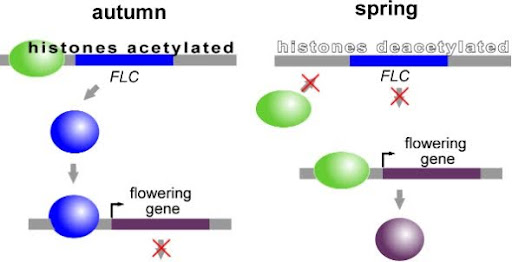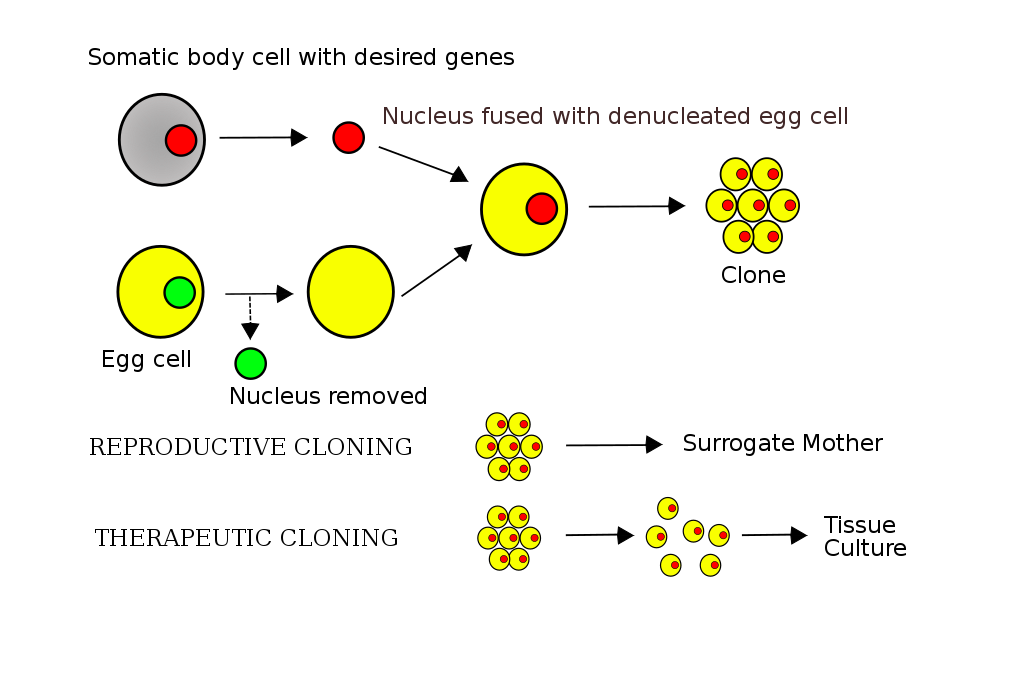Wrap-Up Questions
1. Early evolutionary biologists like Jean-Baptiste Lamarck hypothesized that traits acquired over the course of a lifetime could be inherited by offspring, thus driving evolution. Explain how Lamarckian evolution differs from the theory of natural selection proposed by Charles Darwin.
2. Using online resources, find two examples of how epigenetic changes during a person’s lifetime affect human health. Are your examples of histone modification, DNA methylation, or a mechanism not discussed in this text?
3. Using online resources, find two examples of how epigenetics influences gene expression in specific cell types during embryonic or fetal development. Are your examples of histone modification, DNA methylation, or a mechanism not discussed in this text?
4. Describe how epigenetic changes might explain the incomplete penetrance or variable expressivity of certain genetic traits.

5. Adapted from Online Open Genetics (Nickle and Barrett-Ng)[1]: Epigenetics plays a role in the vernalization of flowering plants – the process by which certain winter annual plants only begin flowering after a prolonged exposure to cold temperatures. This process is controlled by expression of a gene called FLC, which encodes a repressor of genes required for flowering. In the fall and early winter, the histones around the FLC gene are highly acetylated. With prolonged exposure to the cold, histones are gradually deacetylated, reducing transcription of the FLC gene. Without expression of FLC, the plant can then respond to pro-flowering hormones and signals, inducing flowering at the proper time in the spring after cold temperatures have passed. This is illustrated in Figure 15.
What do you think might be the phenotype of a winter annual plant that lacked HDAC function? Explain your reasoning
6. Oncogenesis, or the development of cancer, results when a single cell sustains mutations in tumor suppressors and proto-oncogenes. Tumor suppressor proteins are responsible for protecting somatic cells against becoming cancerous, and most cancer cells have loss-of-function mutations in one or more tumor suppressors.
Loss-of-function mutations in the BRCA1 tumor suppressor gene are linked with breast cancer: up to 70% of women with one loss-of-function allele in either gene will eventually get breast cancer, and their tumors typically show that the second allele has sustained a somatic mutation. This makes such tumor cells homozygous for BRCA1 mutations.
But less than 10% of breast cancer patients have inherited such mutations. Instead, in about 30% of breast cancer patients, tumors show hypermethylation in the region around the BRCA1 gene. What is the most likely consequence of that hypermethylation on BRCA1 expression, and what impact did it likely have on oncogenesis? Explain your reasoning.
7. Hemophilia B, a disorder characterized by excessive bleeding, is caused by a loss of function in factor IX clotting activity. Factor IX is encoded by a gene on the X chromosome. Chromosomal males (XY) who inherit one loss of function allele or chromosomal females (XX) who inherit two loss of function alleles have impaired clotting ability. Heterozygous females typically have lower levels of circulating Factor IX and mild hemophilia but are largely unaffected by the health problems caused by excessive bleeding. How would you predict the phenotype of heterozygous females to be affected by skewed X-inactivation? Explain your reasoning.
Science and Society
8. An increasing body of evidence supports the role of both genetics and epigenetics in human phenotypes like sexual orientation and gender identity. Studies have shown a link between epigenetic changes in gene expression established early in embryonic development and sexually dimorphic brain structures[2].
These studies overwhelmingly validated the experiences of gay and transgender people who understand that their gender identity or sexual orientation is innate and not a matter of social conditioning. However, genetic studies looking for differences between groups of people (often racial or ethnic groups) have also historically been misused to mark groups of people as different or socially inferior in some way, for example connecting brain size to intelligence, despite no evidence to show such a connection.
Explain why epigenetics is rooted in biology as much as genetics. In your opinion, what are the advantages and risks of such studies on sex and gender? How might such information be used for or against the affected community? Use outside resources as appropriate to answer this question and support your argument.
9. The cloning of adult organisms is done through somatic cell nuclear transfer (SCNT). Somatic cell nuclear transfer is the process by which the nucleus from an adult somatic cell is transferred to an egg that has had the nucleus removed. The re-nucleated egg is then induced to divide and form an embryo, which can be implanted into a surrogate mother for gestation. Given what you learned about epigenetics and development, how might the epigenetic markings of the donor nucleus impact the fetus resulting from SCNT? What ethical issues should be considered before cloning of mammals should be performed? Use outside resources as appropriate to answer this question and support your argument.

Media Attributions
- Autumn vs spring © Online Open Genetics, Nickle and Barrett-Ng. Origianl-Deyholos is licensed under a CC BY-SA (Attribution ShareAlike) license
- Cloning diagram
- Nickle and Barrette-Ng. Open Online Genetics. in Open Online Genetics (2016). ↵
- Swaab, D. F., Wolff, S. E. C. & Bao, A.-M. Chapter 31 - Sexual differentiation of the human hypothalamus: Relationship to gender identity and sexual orientation. in Handbook of Clinical Neurology (eds. Swaab, D. F., Buijs, R. M., Lucassen, P. J., Salehi, A. & Kreier, F.) vol. 181 427–443 (Elsevier, 2021). ↵

